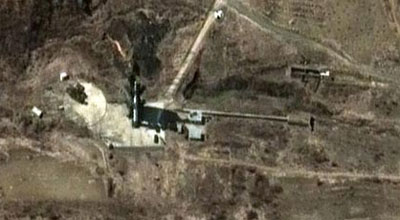North Korea’s missiles: how will they use their ultimate assetby Taylor Dinerman
|
| The South Koreans are no longer under any illusions about the North. They are about to launch their own space launch vehicle using a combination of local and Russian technology. |
The test launch that reports claim is planned for July 4th is in and of itself having some political effect, but not as nearly much as their recent nuclear test. Merely testing missiles is getting them fewer and fewer results. Even the West’s media, always ready to “cry havoc” every time an anti-American dictator says or does something outrageous, is getting bored with the North’s short-range rocket tests. Firing off a few Scuds or coastal defense anti-ship missiles has barely gotten a mention in the major media. Only when such tests are directly connected with the test of an atomic weapon do they get a satisfyingly hysterical response.
Pyongyang’s leaders may find—if they have not done so already—that their missile tests are increasingly being met with a symbolic shrug of the shoulders. This may lead them to try and escalate their actions just to get attention. Like Noriega and Saddam before them, these men may have become addicted to the thrill that they and their supporters get from threatening a superpower without (at least at first) any response.
The South Koreans are no longer under any illusions about the North. They are no longer wiling to pay tribute to Pyongyang. They are about to launch their own space launch vehicle using a combination of local and Russian technology. The South’s own technological prowess means that they could not only match the North’s missile weaponry if they wanted to, but they could build highly accurate deep penetration conventional warheads that might be able to hold at risk all but the deepest bunkers.
The US and its allies, South Korea and Japan, have finally started to deploy serious, layered missile defenses. Even though these are imperfect they are, as of now, enough to blunt the political effects of a conventionally armed North Korean missile attack. This means that in spite of its huge investment in long-range missiles, that government is rapidly losing its option of launching a large scale, intimidating ballistic missile attack on its neighbors. As the months and years go by they are facing with an urgent “use it or lose it” dilemma.
If they do launch a Taepodong against Guam, Hawaii, or against the nearby waters they will be doing more than just killing a few fish or disturbing a stray whale. They will be sending a strong signal that they are trying to intensify the intimidation tactics they have been using against Japan, South Korea, and the US. The message is that they are going to continue to up the stakes in the standoff. In the near future we could see them launch a real strike against real targets. They could blow a hole in, say, a Tokyo parking lot and then dare the allies to do anything about it. For Washington the unattractive choices would be to either launch a retaliatory strike or try and do something diplomatically and thus look weak and contribute to the possible collapse of America’s Asian alliance system.
From a political standpoint the best response would be to build up US and allied missiles defenses throughout the Pacific. This would mean doing something more than just rushing a few ineffective theater missile defense units, such as THAAD, to Oahu and deploying the highly-effective Sea-Based X-Band Radar to the area. It would mean urgently giving the US Navy’s SM-3 interceptor missile system the right software and communications needed to hit long-range incoming warheads, the so-called Engage-on-Remote capability. It would also mean, at a minimum, putting the full 44 Ground Based Interceptors into silos in Alaska and Hawaii. In a slightly longer time frame it would mean seeing if the THAAD system could be modified to give it some minimal capability of hitting a warhead in the terminal phase and fully funding the Airborne Laser program.
It is unlikely that this administration and this Congress will take homeland missile defense seriously. It is not simply a partisan matter: for decades a significant fraction of America’s elite has believed, with various degrees of passion, that defending America’s civilian population is a bad idea. Under Johnson and Nixon, as well as Ford and Carter, the concept of Mutually Assured Destruction (MAD) became deeply embedded in mentality of policymakers in the White House, the State Department, and Defense Department sustained by influential academic networks. When, in March of 1983, Ronald Reagan rejected the logic of the balance of terror, he effectively devalued the life’s work of a large number of influential strategists and political scientists.
Someday, if we are lucky, it may be possible to evaluate the MAD philosophy with the same level of detachment we now examine the theology of Dante or medical techniques of Paracelsus. That day has not yet come and will not for a long time. It has been said that no argument in Washington is ever really over until it is irrelevant. It would be unfortunate, to say the least, if this political fight ended with a missile strike on Honolulu.
